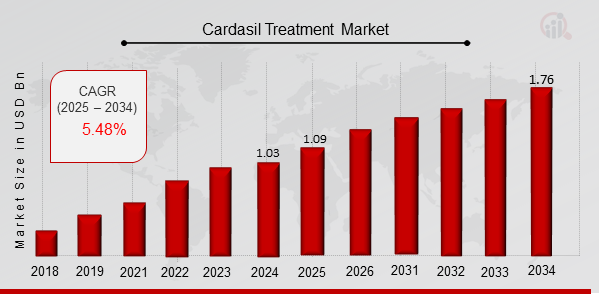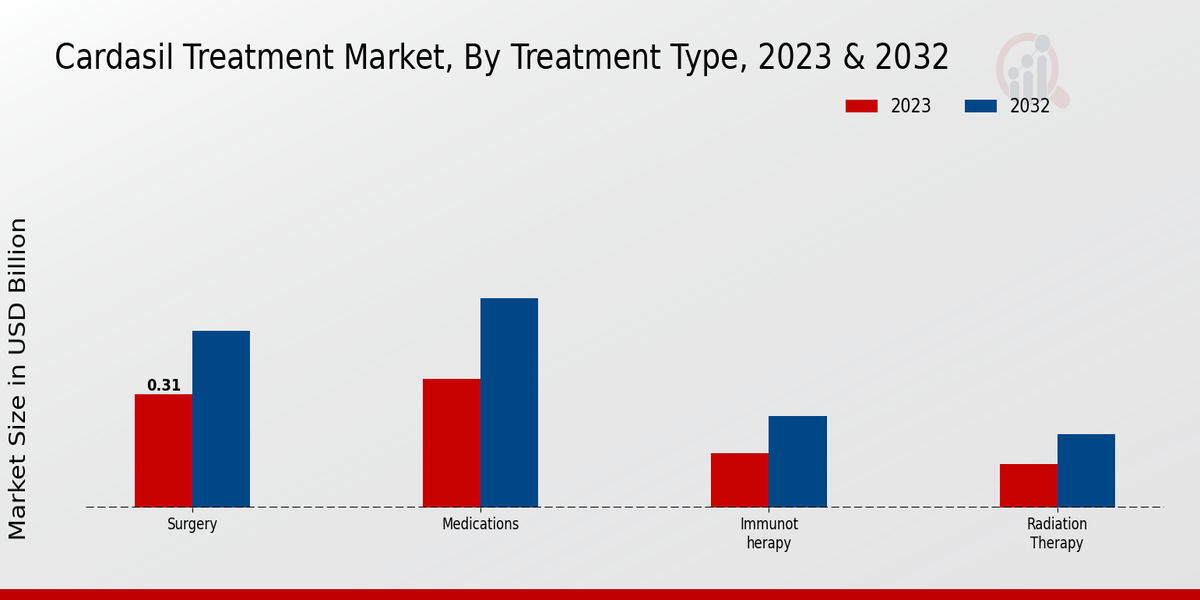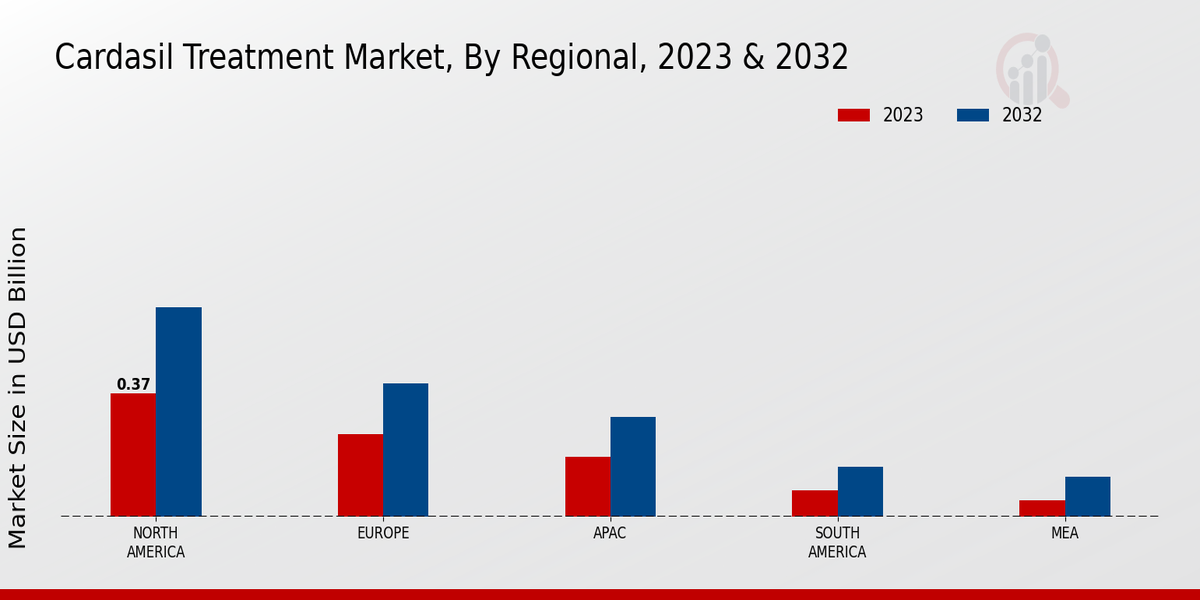Cardasil Treatment Market Overview
As per MRFR analysis, the Cardasil Treatment Market Size was estimated at 1.03 (USD Billion) in 2024. The Cardasil Treatment Market Industry is expected to grow from 1.09 (USD Billion) in 2025 to 1.76 (USD Billion) till 2034, at a CAGR (growth rate) is expected to be around 5.48% during the forecast period (2025 - 2034).
Key Cardasil Treatment Market Trends Highlighted
Several key market drivers characterize the Cardasil Treatment Market. Increasing awareness about the risks associated with human papillomavirus (HPV) has led to greater demand for effective vaccines. Enhanced screening programs and public health initiatives aimed at preventing HPV-related diseases further stimulate market growth. Additionally, the rise in sexually transmitted infections, along with the need for preventive healthcare, is propelling the uptake of Cardasil and similar treatments. The focus on women’s health and preventive care has also encouraged more healthcare providers to recommend vaccination, thereby expanding the market base.
The Cardasil Treatment Market has many untapped opportunities. Due to increasing healthcare awareness and growth in the disposable income, there is a huge opportunity in the emerging markets for the vaccine adoption. Vaccine delivery may be improved, and patient compliance increased, through advances in vaccine formulation and delivery methods. There is a great potential for enhancing the overall market by partnering with pharmaceutical companies and healthcare service providers to enhance the uptake of vaccines in the neglected areas. Besides, there is a need to sensitize healthcare providers regarding the uptake and availability of HPV vaccine through their patients.
The Cardasil Treatment Market has also been engaging more digital health solutions recently. It is also possible for patients to seek care for vaccination via telemedicine services. There are increasing awareness campaigns such as social media campaigns and creation of online platforms that campaign for HPV and vaccination. There is also a greater emphasis on sexual health education in schools and the community which removes stigma surrounding vaccination and sexually transmittable infections. The Cardasil Treatment Market is constantly evolving which shows that there are current efforts towards improving health through vaccination and other preventive measures.

Source: Primary Research, Secondary Research, MRFR Database and Analyst Review
Cardasil Treatment Market Drivers
Increasing Incidence of Cardiovascular Diseases
The rising prevalence of cardiovascular diseases across the globe is a significant driver for the Cardasil Treatment Market Industry. Increasing sedentary lifestyles, poor dietary habits, and the growing aging population contribute to higher rates of heart-related issues. These medical conditions prompt healthcare professionals to focus on effective treatment solutions, such as Cardasil. As awareness of cardiovascular health grows, more patients are seeking proactive measures to manage and mitigate their risks.Consequently, this surge in patient demand is expected to create opportunities for therapies targeting cardiovascular diseases. The market dynamics, shaped by both healthcare professionals and patients, underline the urgency for innovative treatments, driving the advancement and commercialization of Cardasil. The competition among pharmaceutical companies aims to provide more effective and personalized treatment options, thus accelerating growth in the Cardasil Treatment Market.Investments in research and development are on the rise as companies develop specialized formulations and delivery methods to enhance therapeutic outcomes. Furthermore, for healthcare stakeholders, addressing cardiovascular health through effective treatments remains a priority, leading to a sustained growth trajectory in this sector. The convergence of technological advancements with clinical needs showcases a bright future for the Cardasil Treatment Market, reinforcing the significance of robust treatment options in addressing cardiovascular diseases.
Technological Advancements in Treatment Options
Technological innovation plays a pivotal role in shaping the Cardasil Treatment Market Industry. The advancements in drug formulation, delivery systems, and treatment protocols enhance the effectiveness of Cardasil therapies. As research delves deeper into understanding the underlying mechanisms of cardiovascular diseases, newer and more effective treatment options emerge. This continual evolution encourages healthcare providers to adopt innovative solutions, ultimately improving patient outcomes and expanding market reach.The integration of digital health technologies also offers patients better access and adherence to treatment plans, fostering a more engaged patient population.
Government Support and Initiatives
Government initiatives in promoting heart health significantly influence the Cardasil Treatment Market Industry. Many nations are implementing programs aimed at reducing cardiovascular disease prevalence through public awareness campaigns and financial support for treatment options. These efforts enhance access to medication and improve overall health outcomes. Such proactive governmental roles can stimulate growth in the Cardasil treatment sector, fostering a collaborative environment between the public and private healthcare sectors to address cardiovascular health proactively.
Cardasil Treatment Market Segment Insights
Cardasil Treatment Market Treatment Type Insights
The Cardasil Treatment Market has demonstrated considerable growth in the Treatment Type segment, which includes various modalities such as Surgery, Medications, Immunotherapy, and Radiation Therapy. By 2023, the Treatment Type segment is expected to hold significant value, contributing to a total market valued at 0.93 USD Billion, and is projected to witness continued expansion through 2032, when it is estimated to reach 1.5 USD Billion. Each treatment type plays a crucial role in the management and positivization of Cardasil, addressing different needs and preferences among patients and healthcare providers.Within this segment, Surgery holds a majority share, valued at 0.31 USD Billion in 2023 and anticipated to grow to 0.48 USD Billion by 2032. Its significant role in the immediate removal of tumors makes it a primary choice for many patients, reflecting its dominance in real-world applications. Such surgical interventions are often critical in ensuring favorable patient outcomes, justifying why it remains a leading treatment option in the market.Medications also represent a vital component of the Cardasil Treatment Market, valued at 0.35 USD Billion in 2023 and projected to rise to 0.57 USD Billion by 2032.
This growth reflects the increasing reliance on pharmaceutical approaches in treating Cardasil, resulting from advancements in drug formulations and delivery methods that enhance patient compliance and effectiveness. Moreover, the growing trend towards personalized medicine likely fuels the demand for medications, enabling tailored treatment plans that cater to individual patient needs.In contrast, Immunotherapy and Radiation Therapy, while increasingly relevant, occupy smaller portions within the market. Immunotherapy, valued at 0.15 USD Billion in 2023 and expected to reach 0.25 USD Billion by 2032, highlights a growing interest in harnessing the body's immune system to combat Cardasil. Although it currently holds a minor share, it demonstrates significant potential for future growth as ongoing research unveils novel treatment paths and improved patient outcomes.
Lastly, Radiation Therapy, valued at 0.12 USD Billion in 2023 and projected to increase to 0.20 USD Billion by 2032, remains a critical treatment option that complements surgical approaches, particularly for patients who are not candidates for invasive procedures. Its role in palliative care and local tumor control reinforces its importance, despite its relatively lower market valuation.Overall, the segmentation of the Cardasil Treatment Market by Treatment Type reveals a diverse landscape where Surgery leads in both value contributing and utilization, while Medications follow closely behind, reflecting current treatment trends and preferences. Immunotherapy and Radiation Therapy, despite holding smaller shares, are significant areas of focus, driven by ongoing innovations in treatment methodologies and patient-centered care. The interplay between these treatment types indicates a dynamic market landscape characterized by evolving treatment protocols and a strong drive toward improved patient outcomes.

Source: Primary Research, Secondary Research, MRFR Database and Analyst Review
Cardasil Treatment Market Indication Insights
The Cardasil Treatment Market, with an expected market valuation of 0.93 billion USD in 2023, showcases a robust growth trajectory driven by rising awareness and the prevalence of diseases linked to human papillomavirus (HPV). This market can be segmented into various indications, primarily including Cervical Cancer, Anal Cancer, and Head and Neck Cancer, which play crucial roles in influencing market dynamics. Among these, Cervical Cancer remains a major focus due to its significant public health impact and the increasing adoption of vaccination programs.Anal Cancer is gaining attention as awareness of HPV-related risks rises, showing promise in treatment advancements. Additionally, Head and Neck Cancer, although less prevalent, is becoming more notable given its association with HPV and growing patient demographics. The prevalence of these cancers, fueled by lifestyle changes and improved screening practices, underscores the importance of understanding this Cardasil Treatment Market segmentation, indicating substantial opportunities for growth in coming years amid evolving healthcare landscapes and increased funding in oncology.
Cardasil Treatment Market Patient Demography Insights
The Patient Demography segment of the Cardasil Treatment Market plays a crucial role in understanding the diverse needs of various age groups, alongside shaping tailored treatment strategies. In 2023, the market is valued at 0.93 billion USD, reflecting the growing need for effective treatments across different age demographics. Children represent a significant portion of this market as early intervention plays a vital role in mitigating long-term effects associated with the disease. Meanwhile, the Adult demographic continues to dominate, driven by increasing incidence rates and wider awareness of vaccination benefits.The Elderly cohort also holds considerable importance, contributing to the overall market dynamics as they tend to have a higher susceptibility to related health issues. Moreover, rising health awareness and advancements in treatment methodologies across all age groups are expected to support overall market growth. Factors such as technological advancements, increased healthcare expenditure, and strategic collaborations within the Cardasil Treatment Market industry further contribute to its expansion. However, challenges like unequal access to healthcare services could hinder growth in certain regions, making targeted outreach vital to tap into significant opportunities within these populations.
Cardasil Treatment Market Administration Route Insights
The Cardasil Treatment Market has displayed significant growth potential, particularly within the Administration Route segment. In 2023, the overall market was valued at approximately 0.93 USD Billion, reflecting the increasing demand for effective treatments. Key routes such as Intravenous, Oral, and Topical administration are crucial, as they cater to diverse patient needs and preferences. Intravenous administration often ensures rapid therapeutic effects, making it important in acute care settings. Oral routes provide convenience and ease of administration, appealing to a larger patient demographic.Topical methods, meanwhile, present localized treatment options that minimize systemic exposure, which are increasingly valued in patient care strategies. The ongoing research and developments in this area continue to enhance Cardasil Treatment Market statistics, reflecting a positive trend in market growth and diversification.
Cardasil Treatment Market Regional Insights
The Regional segment of the Cardasil Treatment Market shows a promising trajectory, with the overall market valued at 0.93 USD Billion in 2023, indicating a steady growth trend. North America holds the majority share, valued at 0.37 USD Billion in 2023, and is projected to grow to 0.63 USD Billion in 2032, reflecting its dominance in market growth due to advanced healthcare infrastructure and significant investments in research and development. Europe follows, valued at 0.25 USD Billion in 2023, with expectations of reaching 0.4 USD Billion by 2032, marking it as a significant player in the market with a strong emphasis on innovative treatment solutions.The Asia Pacific (APAC) region is also noteworthy, with a valuation of 0.18 USD Billion in 2023, projected to rise to 0.3 USD Billion in 2032, indicating the region's increasing focus on expanding healthcare access and improving treatment outcomes. South America and the Middle East Africa (MEA) segments, although smaller, valued at 0.08 USD Billion and 0.05 USD Billion respectively in 2023, are expected to gradually grow, highlighting emerging opportunities in these regions for Cardasil treatment. The overall insights into this market segmentation reveal distinct region-specific dynamics that are driving the Cardasil Treatment Market Statistics and future growth.

Source: Primary Research, Secondary Research, MRFR Database and Analyst Review
Cardasil Treatment Market Key Players and Competitive Insights
The Cardasil Treatment Market is characterized by an increasing demand for effective medical interventions against the human papillomavirus, which is known to cause several types of cancers. Due to the rising prevalence of HPV-related diseases, various pharmaceutical companies are focused on developing and marketing innovative treatments, leading to fierce competition in this sector. The market is influenced by factors such as government regulations, reimbursement policies, and an increasing awareness among the population regarding the importance of vaccination and treatment options. Continued research and development efforts are fueling advancements in vaccine efficacy and delivery systems, making competitive insights essential for understanding the market landscape and identifying key players striving for a prominent position.Sanofi has established a noteworthy presence in the Cardasil Treatment Market, boasting several strengths that bolster its competitive edge.
The company's commitment to research and development ensures that it remains at the forefront of innovation, with a portfolio that emphasizes both effectiveness and safety in its vaccine offerings. Sanofi's extensive global distribution network enables it to reach diverse markets, thereby increasing accessibility for patients who require Cardasil treatment. Furthermore, the company leverages strategic partnerships and collaborations to enhance its research capabilities and streamline processes. Sanofi's strong brand reputation built over years in the pharmaceutical industry contributes to consumer trust, which is vital in the healthcare sector, particularly within vaccine administration.Merck and Co are another significant player in the Cardasil Treatment Market, recognized for its robust research and commercialization efforts.
The company has developed a comprehensive understanding of the dynamics within the HPV vaccine landscape, allowing it to position its products effectively against competitors. Merck and Co's strength lies in its innovative approach to vaccine development, exemplified by its commitment to rigorous clinical trials that ensure high safety and efficacy standards. The company also strategically invests in marketing campaigns aimed at raising awareness about the benefits of vaccination, particularly in populations at risk. Its established relationships with healthcare providers and institutions further enhance Merck and Co's ability to penetrate various segments of the market, making it a key contender in the ever-evolving landscape of Cardasil treatment options.
Key Companies in the Cardasil Treatment Market Include
- Sanofi
- Merck and Co
- GSK
- AbbVie
- AstraZeneca
- Eli Lilly and Company
- Bayer
- BristolMyers Squibb
- Takeda Pharmaceutical
- Roche
- Johnson and Johnson
- Pfizer
- Novartis
- Amgen
- Regeneron Pharmaceuticals
Cardasil Treatment Market Industry Developments
Recent developments in the Cardasil Treatment Market have been marked by significant advancements and strategic initiatives from major pharmaceutical companies. Sanofi, Merck Co., GSK, and AbbVie are intensifying their research and development efforts to enhance the efficacy of existing vaccines and treatments. AstraZeneca and Eli Lilly have also announced collaborations aimed at expanding their product portfolios in this niche market. Noteworthy merger and acquisition news includes partnerships between key players such as Johnson Johnson and Bayer, which seek to broaden their therapeutic pipelines and improve market reach. This consolidation trend is being driven by the need for innovative therapies and increasing competition. Additionally, market valuation growth for companies involved in Cardasil treatment is being reflected in their stock performance, indicating positive investor sentiment and strong demand for their products. Companies are also focused on global expansion, particularly in emerging markets, as awareness about Cancers related to HPV elevates the need for preventive measures. These dynamics are shaping the landscape of the Cardasil Treatment Market, fostering innovation, collaboration, and competitive engagement among leading firms.
-
Cardasil Treatment Market Segmentation Insights
-
Cardasil Treatment Market Treatment Type Outlook
- Surgery
- Medications
- Immunotherapy
- Radiation Therapy
-
Cardasil Treatment Market Indication Outlook
- Cervical Cancer
- Anal Cancer
- Head and Neck Cancer
-
Cardasil Treatment Market Patient Demography Outlook
-
Cardasil Treatment Market Administration Route Outlook
-
Cardasil Treatment Market Regional Outlook
-
North America
-
Europe
-
South America
-
Asia Pacific
-
Middle East and Africa
| Report Attribute/Metric |
Details |
|
Market Size 2024
|
1.03 (USD Billion)
|
|
Market Size 2025
|
1.09 (USD Billion)
|
|
Market Size 2034
|
1.76 (USD Billion)
|
|
Compound Annual Growth Rate (CAGR)
|
5.48 % (2025 - 2034)
|
|
Report Coverage
|
Revenue Forecast, Competitive Landscape, Growth Factors, and Trends
|
|
Base Year
|
2024
|
|
Market Forecast Period
|
2025 - 2034
|
|
Historical Data
|
2020 - 2024
|
| Market Forecast Units |
USD Billion |
| Key Companies Profiled |
Sanofi, Merck and Co, GSK, AbbVie, AstraZeneca, Eli Lilly and Company, Bayer, BristolMyers Squibb, Takeda Pharmaceutical, Roche, Johnson and Johnson, Pfizer, Novartis, Amgen, Regeneron Pharmaceuticals |
| Segments Covered |
Treatment Type, Indication, Patient Demography, Administration Route, Regional |
| Key Market Opportunities |
Increasing HPV vaccination rates, Growing awareness of cervical cancer, Expanding access to healthcare in developing regions, Rising prevalence of HPV-related diseases, Advancements in immunotherapy treatments |
| Key Market Dynamics |
rising HPV prevalence, increasing healthcare expenditure, growing awareness and education, advancements in treatment options, expanding patient population |
| Countries Covered |
North America, Europe, APAC, South America, MEA |
Frequently Asked Questions (FAQ) :
The Cardasil Treatment Market is expected to be valued at 1.76 USD Billion by 2032.
The projected CAGR for the Cardasil Treatment Market from 2025 to 2034 is 5.48%.
North America holds the largest market share in the Cardasil Treatment Market, valued at 0.37 USD Billion in 2023.
The Immunotherapy segment is valued at 1.03 USD Billion in the Cardasil Treatment Market for the year 2024.
Major players in the Cardasil Treatment Market include Sanofi, Merck and Co, GSK, AbbVie, and AstraZeneca.
The Medications segment is expected to be valued at 0.57 USD Billion by 2032.
The South America segment is expected to grow to 0.15 USD Billion by 2032.
The Surgery treatment segment is projected to be valued at 0.48 USD Billion in 2032.
The APAC region is expected to show significant growth, projected to be 0.3 USD Billion by 2032.
The Radiation Therapy segment is estimated to reach a market size of 0.2 USD Billion by 2032.

















